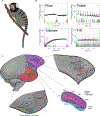The neurobiology of vocal communication in marmosets
- PMID: 37615212
- PMCID: PMC10592205
- DOI: 10.1111/nyas.15057
The neurobiology of vocal communication in marmosets
Abstract
An increasingly popular animal model for studying the neural basis of social behavior, cognition, and communication is the common marmoset (Callithrix jacchus). Interest in this New World primate across neuroscience is now being driven by their proclivity for prosociality across their repertoire, high volubility, and rapid development, as well as their amenability to naturalistic testing paradigms and freely moving neural recording and imaging technologies. The complement of these characteristics set marmosets up to be a powerful model of the primate social brain in the years to come. Here, we focus on vocal communication because it is the area that has both made the most progress and illustrates the prodigious potential of this species. We review the current state of the field with a focus on the various brain areas and networks involved in vocal perception and production, comparing the findings from marmosets to other animals, including humans.
Keywords: Callithrix jacchus; neurobiology; neuroethology; social behavior; vocal communication.
© 2023 The Authors. Annals of the New York Academy of Sciences published by Wiley Periodicals LLC on behalf of New York Academy of Sciences.
Conflict of interest statement
COMPETING INTERESTS
The authors declare no competing interests.
Figures



Similar articles
-
A quantitative acoustic analysis of the vocal repertoire of the common marmoset (Callithrix jacchus).J Acoust Soc Am. 2015 Nov;138(5):2906-28. doi: 10.1121/1.4934268. J Acoust Soc Am. 2015. PMID: 26627765 Free PMC article.
-
Marmoset vocal communication: Behavior and neurobiology.Dev Neurobiol. 2017 Mar;77(3):286-299. doi: 10.1002/dneu.22464. Epub 2016 Oct 26. Dev Neurobiol. 2017. PMID: 27739195 Review.
-
Distinct Neural Activities in Premotor Cortex during Natural Vocal Behaviors in a New World Primate, the Common Marmoset (Callithrix jacchus).J Neurosci. 2016 Nov 30;36(48):12168-12179. doi: 10.1523/JNEUROSCI.1646-16.2016. J Neurosci. 2016. PMID: 27903726 Free PMC article.
-
Acoustic analysis of vocal development in a New World primate, the common marmoset (Callithrix jacchus).J Acoust Soc Am. 2006 Sep;120(3):1655-70. doi: 10.1121/1.2225899. J Acoust Soc Am. 2006. PMID: 17004487
-
Marmosets: A Neuroscientific Model of Human Social Behavior.Neuron. 2016 Apr 20;90(2):219-33. doi: 10.1016/j.neuron.2016.03.018. Neuron. 2016. PMID: 27100195 Free PMC article. Review.
Cited by
-
Representing the dynamics of natural marmoset vocal behaviors in frontal cortex.Neuron. 2024 Nov 6;112(21):3542-3550.e3. doi: 10.1016/j.neuron.2024.08.020. Epub 2024 Sep 23. Neuron. 2024. PMID: 39317185
-
A humanized NOVA1 splicing factor alters mouse vocal communications.Nat Commun. 2025 Feb 18;16(1):1542. doi: 10.1038/s41467-025-56579-2. Nat Commun. 2025. PMID: 39966351 Free PMC article.
-
A model of marmoset monkey vocal turn-taking.Proc Biol Sci. 2024 Jul;291(2026):20240150. doi: 10.1098/rspb.2024.0150. Epub 2024 Jul 3. Proc Biol Sci. 2024. PMID: 38955229 Free PMC article.
-
Functional specialization and distributed processing across marmoset lateral prefrontal subregions.Cereb Cortex. 2024 Oct 3;34(10):bhae407. doi: 10.1093/cercor/bhae407. Cereb Cortex. 2024. PMID: 39390711 Free PMC article.
-
Neural activity for complex sounds in the marmoset anterior cingulate cortex.Commun Biol. 2024 Oct 11;7(1):1310. doi: 10.1038/s42003-024-07019-2. Commun Biol. 2024. PMID: 39394433 Free PMC article.
References
Publication types
MeSH terms
Grants and funding
LinkOut - more resources
Full Text Sources

